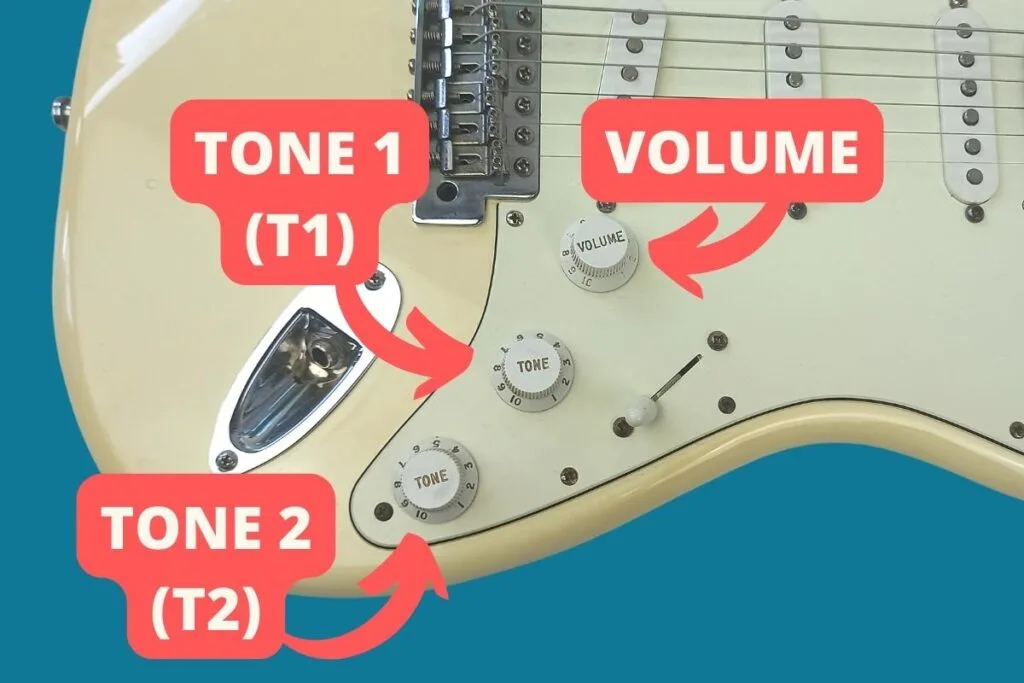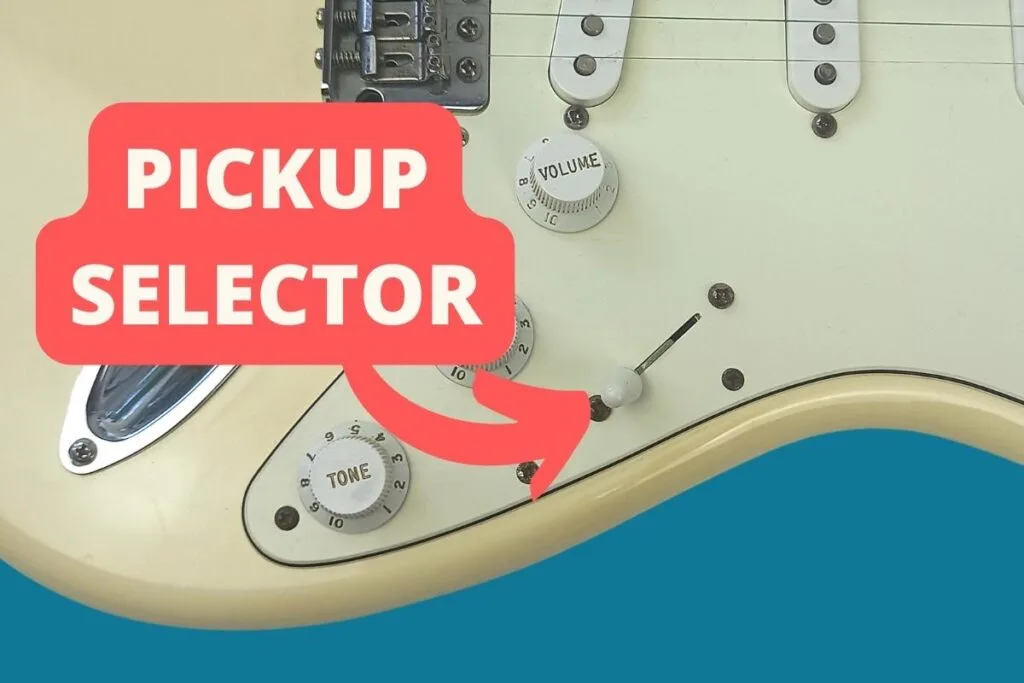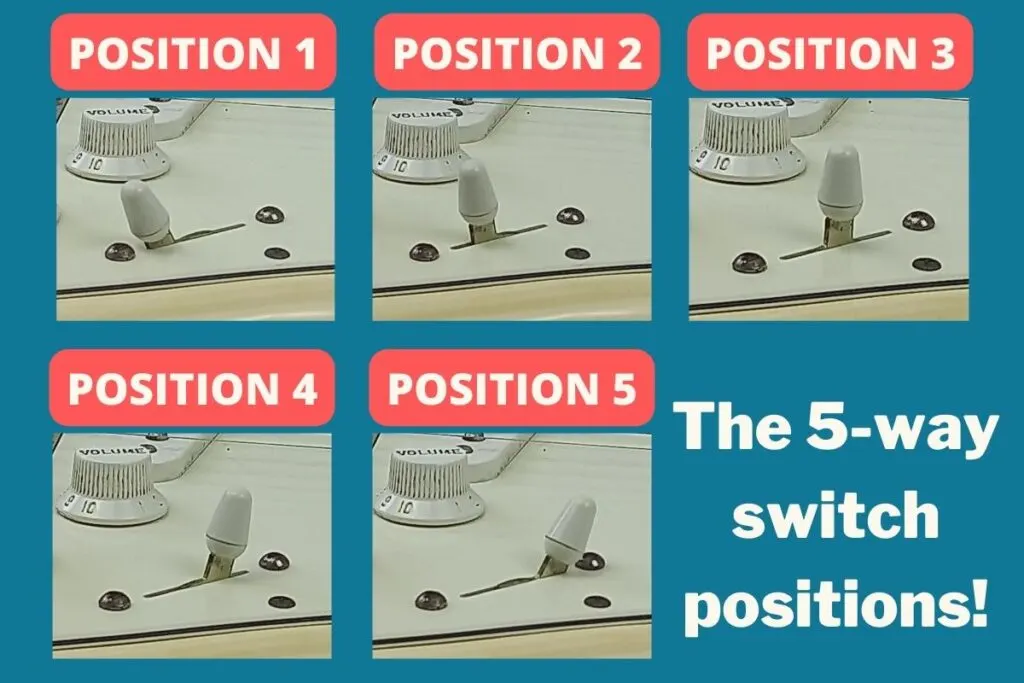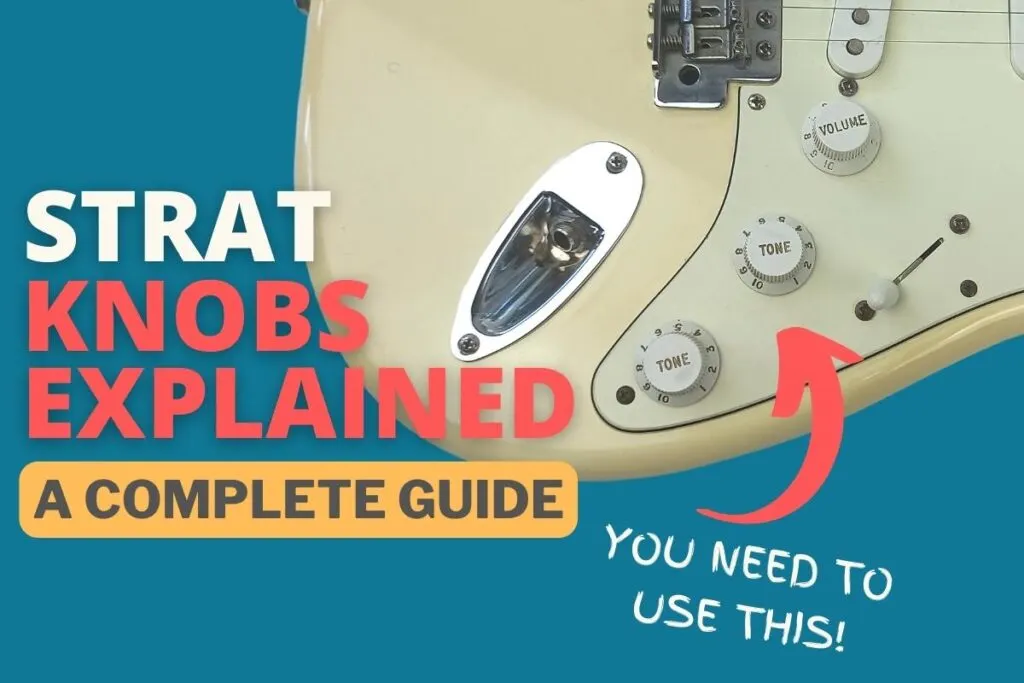The Stratocaster is an instantly recognizable guitar that’s used by both beginners and professionals alike. It comes with a set of three knobs that I feel are often underused by guitarists. When used properly, these knobs can really change the way you play – for the better!
The Fender Stratocaster has a volume knob and two tone knobs. The volume knob controls the overall volume of the guitar. The two tone knobs control the tone on either the neck or the middle and bridge pickup – though the specific configuration varies across models. There is also a pickup selector which switches between different combinations of the three pickups.
Simple, right? Well, there’s more to it than that! Did you know that the volume has a slight affect on the overall tone? Or how about getting that iconic Fender “quack” sound?
I’ve covered all that and more in this complete guide!
The Stratocaster knobs explained
There are three knobs on a Stratocaster’s body, slightly to the right of the pickup selector. They sit in a diagonal line, placing some higher on the body than others. At the top we have the volume control knob, followed by two tone knobs.

All these knobs are “potentiometers”, or “pots”. Pots are variable resistors, meaning that they can change the amount of resistance in a circuit by being turned up or down. The change in resistance will affect the guitar signal in different ways, depending on the knob.
That’s about as technical as I’ll get as far as electronics goes. So, let’s look at the different types of knobs and how they affect your sound.
The tone knobs
The other two knobs are the ones we are focusing on now – since they are the Stratocaster’s tone control knobs. The configuration of these knobs has changed over the years, but the standard configuration according to Fender’s official website is that the middle of the three knobs (“T1”) is the tone control for the neck pickup, and the lower knob (“T2”) controls the middle and bridge pickup’s tone.
Now, this wasn’t always the case. In fact, Stratocasters used to not have any tone control for the bridge pickup at all. Personally, I’ve only ever owned Stratocasters that have a shared tone control for bridge pickup (and why wouldn’t you want tone control for your bridge pickup?!).
Nowadays, it appears that the configurations have changed slightly again – at least according to Fender’s product specifications for its latest product lines. Pretty much every new Stratocaster is set up with T1 controlling the neck and middle pickups, and T2 dedicated to the bridge. (The only exception I could find was the American Original 50’s Stratocaster which has the shared middle and bridge pickup on T2!)

What the tone knobs do
Okay, but what do the tone knobs actually do? Well, their purpose is to change the frequency of the signal that your Stratocaster sends to the amplifier. A lower setting reduces the higher frequencies, making your guitar sound a bit deeper. As you turn the knob to higher levels and all the way up, you will hear more high end frequencies coming through.
In fact, I’ve put a little audio demonstration together. Listen to how the sound of this chord changes when I turn the tone knob all the way down, and back up again.
Crazy, right? All I’m doing is turning the tone knob down and then up. It goes from sounding bright, to sounding underwater! But, there’s a whole range of sounds possible between zero and ten.
These knobs only lower the high end frequencies (called “treble”) – they don’t actively raise any lower frequencies (“bass”). A lower tone setting may cause the bass frequencies to come over more clearly, giving it a deeper sound, but the bass frequencies themselves aren’t actually changing.
If you’re interested in the in-depth science of it (with graphs and equations) check out this article on Medium.com.
Setting your pickups’ tone to a lower setting will give you a deep, bass-rich sound that’s great for the lower power chord riffs that are so popular with metal and hard rock music.
One of the main uses of the tone knobs, though, is to adjust your guitar’s sound for live performances. Treble can be a bit overwhelming at higher volumes, so you might find that you’ll want to tone things down a bit (pun intended) for the show, but dial it back up for a solo that will cut through the band.
Your tone knobs have a huge impact on the sound of your guitar. Try getting to know them better, and soon you’ll be to get a whole range of sounds out of your guitar with without need to touch your guitar amp or pedal!
The volume knob
The volume knob is the simplest one to explain, by far. It does the same thing that any volume knob does – it adjusts the volume! But, that’s not all…
The volume knob on a Stratocaster also has a slight effect on the tone of the guitar. Why? Well, it gets a bit technical, but essentially the increased resistance in the circuit “rolls-off” the treble frequencies. Here’s a great resource that goes into the full ins-and-outs.
It’s a well documented phenomenon, and there are modifications you can make to avoid it (if you’re handy with a soldering iron!).
Getting to know the volume knob is very important for both live and studio playing. If the volume’s too low, you’re not going to be heard, but if it’s too high then you may get distortion – and not the fun kind! Learning to find the sweet spot is a great skill to have to get the perfect mix wherever you’re playing.
Top tip: Here’s something that I do when playing live.
Set your guitar volume to max and the amp to a volume that’s just louder than your band – but not too loud. Then, roll the guitar’s volume knob back a little to sit better in the mix.
When it’s solo time: crank that volume knob up! Not only will your guitar be a little louder, you’ll also get the extra treble frequencies that will really cut through in a live mix.
The Stratocaster pickup selector explained
The Stratocaster’s pickup selector is equally as important for shaping the tone of your sound (maybe even more so). Leo Fender initially designed the Stratocaster to have three single-coil pickups, which is still the most common design today. While some models of Stratocaster will have a different setup, like two humbuckers, the three single-coil pickups design is the most common and the one that most people are familiar with.

The three pickups
To understand the pickup selector, let’s take a quick look at the pickups. The three pickups are spaced more or less evenly across the playable area of the guitar’s body. One is close to the neck, the next one is in the middle of the body, and the last one next to the bridge (at a slight angle, which is normal!).
Read more: All Guitar Pickup Types Explained
Instead of using all three pickups at once, the Stratocaster has a pickup selector (usually with a plastic knob at the end for easy use). This pickup selector will switch between different pickup combinations. This is because the three pickups have very different sounds due to their location on the guitar’s body and the way the strings vibrate in that location.
The bridge pickup has a bright and sharp tone that works particularly well with lead guitar, for example, playing rock or metal guitar solos using distortion or other similar effects. The neck pickup’s tone is slightly more mellow and warm. It is most commonly used for clean-signals or for rhythm guitar.
The middle pickup is somewhere in the middle, in both location and sound! You get some of the warmth of the neck pickup along with some of the brightness of the bridge pickup. It’s a comfortable compromise between the two for general guitar playing.
Of course, these are just very general suggestions- you can use each pickup however sounds best to you. And with the Stratocaster pickup selector, you aren’t just limited to using one pickup!
Using the Stratocaster pickup selector (the 5-way switch)
The pickup selector knob has five positions. You don’t simply have to choose between the three pickups, but rather you have the option of using a combination of them! The positions are:
- The first position is the one closest to the bridge. This position uses only the bridge pickup; the other two pickups are disabled. This position will give you the sharpest, brightest sound. It’s the perfect setting for players who like to play rocking leads.
- If you move the selector switch to the next position, you’ll use both the middle pickup and the bridge pickup. This setting has more mid frequencies than the first position. It’s great for that classic Fender “quack” sound.
- Moving the selector to the third position will switch it entirely to the middle pickup. The bridge and neck pickups will be inactive with this setting.
- The next position uses both the neck pickup and the middle pickup. Your sound will still have some mid “quack” but will be much mellower.
- With the switch in the fifth position, only the neck pickup will be used. This will give you the warmest, most mellow tone.

What about using all three pickups together?
Now, you might be wondering why there aren’t any settings to use all three pickups simultaneously. Currently, this isn’t something that Fender offer as stock. There are some online wire diagrams that can show you how to activate all three pickups simultaneously. Some argue that it’s pointless and makes no difference to the sound, while others claim that it gives the Stratocaster an even fuller tone that’s perfect for a style like smooth jazz.
Whatever the case may be, the Stratocaster doesn’t have this option built-in as of yet. But if you are interested in this (and you don’t mind voiding your guitar’s warranty), you can make some modifications to your electronics. Personally, I think you get enough tonal variety from the stock set up!
Adjusting the Stratocaster knobs for different pickups
As you work your way through the different pickups, you’ll notice that the same settings on the knobs will have different sounds. For example, a setting of five on the middle pickup’s tone knob won’t sound the same as a level five on that of the neck pickup.
These pickups (and, by extension, their knobs) sound different because of where the pickups are located.
The strings vibrate differently in different sections and areas of the guitar. They vibrate more towards the neck, and the vibrations become less and less as they move closer to the bridge. That’s because the bridge is the fixed point that’s closest to the playing area on the body. The other fixed point is all the way at the other end of the neck, giving the strings more freedom to vibrate.
This makes the neck pickup sound louder. All sounds are vibrations, and more intense vibrations in the strings equate to “louder” sounds. So the neck pickup tends to sound the loudest of the three, which is also why an adjustment on its tone and volume knob will make a more pronounced difference than adjusting that of the other pickups!
The best Stratocaster settings for beginners
A lot of beginner guitarists (myself included, back in the day) often look for the “best” settings to emulate their guitar heroes. For guitar settings: there isn’t a best.
Sure, using the bridge pickup will give you a brighter sound. Rolling off the tone will sound slightly darker. Using the second pickup position will give you some added mid frequencies that will give you a “quack”. But, at the end of the day – the best setting is the one that you need for your song.
Sorry. It might not be the answer you’re looking for. But, I can give you something even better. I can teach you how to get the perfect setting every time with these three simple exercises.
Exercise 1: Learning the volume knob
Set your volume knob to zero. Then, turn it up very slightly and play something and listen to how it sounds. Now, try turning it up a little more and playing the same thing. Repeat this until you find a setting that sounds good to you. This is the “sweet spot”.
Exercise 2: Learning the tone knob
Set the tone knob to zero (make sure it’s the right tone knob for the pickup you’re using!). Now, play something and listen to how it sounds. Next, turn it up slightly and play the same thing and compare it. Again, repeat this until you find what sounds good to you. Learning to do this changed the way that I play guitar.
Exercise 3: Learning the pickup selector
Set your tone and volumes to max. Set the pickup selector to the neck position and play something. Now, move it to the next position and play the same thing and compare the two. Then, work your way through each of the different positions to learn how they sound. Combine this exercise with the other two to really learn how varied each pickup can sound. It really is astounding!
Conclusion
The Fender Stratocaster is a dynamic guitar that totally deserves its popularity. The combination of tone, volume, and pickup selector controls gives it an almost infinite number of settings that you can adjust before you even touch your amp or pedals!
In my opinion, this makes it a great beginner guitar to learn on. Don’t be afraid to play around with different combinations and listen to the sounds they produce. Those knobs are there for a reason, so use them!


Conor is a music producer, multi-instrumentalist, and all-round enthusiast from the UK with over 15 years of experience. He’s the founder and sole-content creator for the roundtable audio blog and YouTube channel.
